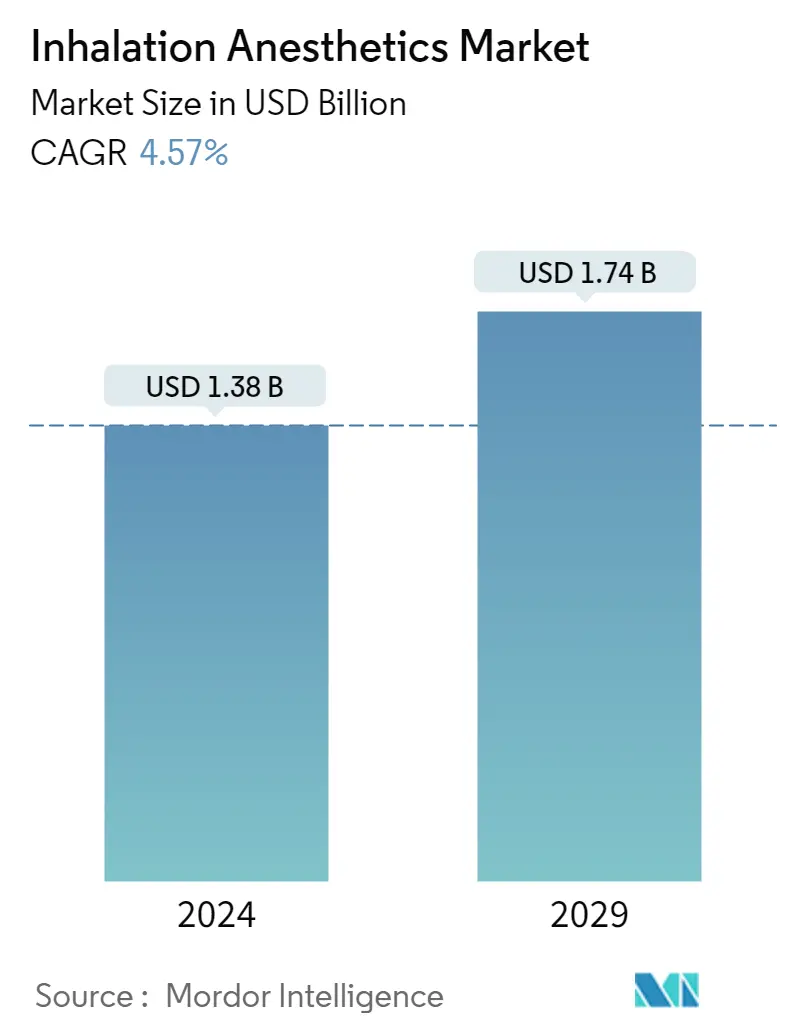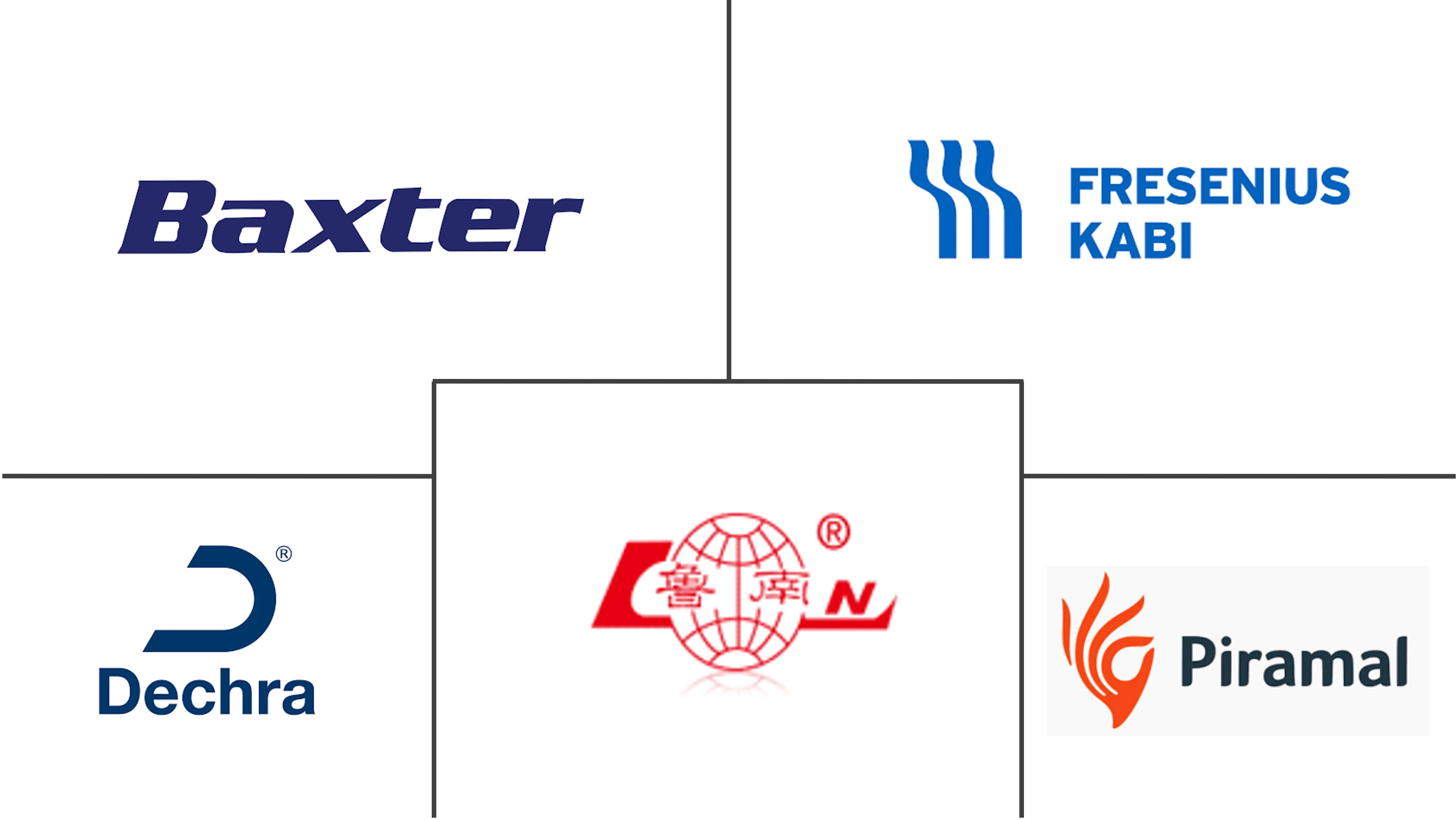Market Size of Inhalation Anesthetics Industry

| Study Period | 2019 - 2029 |
| Market Size (2024) | USD 1.38 Billion |
| Market Size (2029) | USD 1.74 Billion |
| CAGR (2024 - 2029) | 4.57 % |
| Fastest Growing Market | Asia Pacific |
| Largest Market | North America |
Major Players
*Disclaimer: Major Players sorted in no particular order |
Inhalation Anesthetics Market Analysis
The Inhalation Anesthetics Market size is estimated at USD 1.38 billion in 2024, and is expected to reach USD 1.74 billion by 2029, growing at a CAGR of 4.57% during the forecast period (2024-2029).
The application of inhalation anesthetics for the diagnosis and treatment of COVID-19 and associated diseases has positively impacted the market's growth. Volatile agents are effective in patients who need complex and high sedation, significantly reducing or removing intravenous sedatives. Volatile agents contain mild muscle relaxation properties and may lower the usage of paralytic agents and benefit the lungs.
For instance, the article entitled 'Inhalational Volatile-Based Sedation for COVID-19 Pneumonia and ARDS' published in June 2020, states that isoflurane offers the highest potency with low dosing requirements for ICU patients. And these Volatiles are delivered to the patients through either an anesthesia machine or ICU ventilator with an in-line miniature vaporizer. These mini vaporizers are used to block the inhalation of carbon dioxide. And the article concluded that delivery of inhaled volatile sedation regimens with a good sedation profile might have benefits in the lung while easing pressure on essential sedative medications.
The market is expected to grow due to the increase in the number of surgeries performed globally. For instance, The Centre for Disease Control and Prevention (CDC) data updated in March 2022 related to Emergency Department Visits in the United States shows that, in the year 2020, 130 million emergency hospital visits and the number of injury-related visits were 35 million. This number increased from the prior year. In 2020, employers reported 2.7 million injury and illness cases in private industry. Injury cases declined to 2.1 million in 2020 from 2.7 million in 2019, while illness cases more than quadrupled to 544,600 cases in 2020, shows the United States Bureau Of Labor Statistics data. This surge in emergency cases and related increase in surgical interventions are among the few factors estimated to drive the growth of the studied market.
The factors, such as the increasing adoption rate of minimally invasive surgeries, are also helping the market growth due to their effectiveness in a lesser hospitalization period. Minimally invasive surgeries have been reported to cause less post-operative pain. Hence, the patients receive smaller dosages of painkillers. Additionally, as minimal cuts or stitches are involved, the hospital stay is relatively shorter, and the patients need not visit the hospital frequently. For instance, Becker's Spine Review data updated in December 2020 shows that more than 160 ASCs are performing minimally invasive spine surgery in the United States, which has grown significantly in the past decade. Similarly, Florida has 15 ASCs which offer minimally invasive spine surgery, which is the most of any other state.
However, side effects associated with the inhalation anesthetics, the lower adoption rate in case of inhaled anesthetics in certain surgical procedures, generic competition for almost all of the halogenated agents, and recent patent expiries are restraining the inhalation anesthetics market.
Inhalation Anesthetics Industry Segmentation
As per the scope of the report, inhalational anesthetics are used for the induction and maintenance of general anesthesia and sedation. The exact mechanisms by which they function are still unknown. The most common inhalational anesthetics are sevoflurane, desflurane, and nitrous oxide. Of these, sevoflurane is the most common due to its rapid onset of action and quick patient recovery. The Market is Segmented by Type (Desflurane, Sevoflurane, Isoflurane, and Other Types), End-User (Hospital, Ambulatory Surgical Centers, and Other End Users), and by Geography (North America, Europe, Asia-Pacific, Middle-East and Africa, and South America). The market report also covers the estimated market sizes and trends for 17 different countries across major regions, globally. The report offers the value (in USD million) for the above segments.
| By Type | |
| Desflurane | |
| Sevoflurane | |
| Isoflurane | |
| Other Types |
| By End User | |
| Hospitals | |
| Ambulatory Surgical Centers | |
| Other End Users |
| Geography | ||||||||
| ||||||||
| ||||||||
| ||||||||
| ||||||||
|
Inhalation Anesthetics Market Size Summary
The inhalation anesthetics market is poised for steady growth over the forecast period, driven by several key factors. The increasing application of inhalation anesthetics in the diagnosis and treatment of COVID-19 has positively influenced market expansion. Volatile agents, such as isoflurane and sevoflurane, are gaining traction due to their effectiveness in providing complex sedation while reducing the need for intravenous sedatives. These agents are particularly beneficial in surgical settings, where their mild muscle relaxation properties can decrease the use of paralytic agents and offer advantages for lung health. The rising number of surgeries globally, coupled with the growing adoption of minimally invasive procedures, is further propelling market growth. Minimally invasive surgeries are favored for their reduced post-operative pain and shorter hospital stays, which contribute to lower dosages of painkillers and fewer hospital visits.
Despite the positive growth trajectory, the inhalation anesthetics market faces challenges such as side effects associated with these agents, lower adoption rates in certain surgical procedures, and competition from generic alternatives following recent patent expiries. Sevoflurane, in particular, remains a dominant player in the market due to its therapeutic advantages, cost-effectiveness, and suitability for both adult and pediatric patients. The market is also witnessing increased research into combining sevoflurane with other anesthetic drugs to enhance efficacy. Additionally, the North American market is experiencing growth due to increased government funding for research and development, alongside a rise in cancer incidences necessitating surgical interventions. Market players are actively expanding their product portfolios through strategic partnerships and acquisitions, further contributing to the market's dynamic landscape.
Inhalation Anesthetics Market Size - Table of Contents
-
1. MARKET DYNAMICS
-
1.1 Market Overview
-
1.2 Market Drivers
-
1.2.1 Increasing Geriatric Population Prone to Chronic Diseases
-
1.2.2 Increasing Number of Emergency Cases and Surgical Interventions
-
1.2.3 Growing Demand for Lesser Duration in Hospitalization
-
1.2.4 Increasing Accessibility to Health Services and Surgeries
-
-
1.3 Market Restraints
-
1.3.1 Generic Competition for Almost All Halogenated Agents
-
1.3.2 Side-effects of Inhaler Anesthesia Drugs
-
-
1.4 Porter's Five Forces Analysis
-
1.4.1 Threat of New Entrants
-
1.4.2 Bargaining Power of Buyers/Consumers
-
1.4.3 Bargaining Power of Suppliers
-
1.4.4 Threat of Substitute Products
-
1.4.5 Intensity of Competitive Rivalry
-
-
-
2. MARKET SEGMENTATION (Market Size by Value - USD million)
-
2.1 By Type
-
2.1.1 Desflurane
-
2.1.2 Sevoflurane
-
2.1.3 Isoflurane
-
2.1.4 Other Types
-
-
2.2 By End User
-
2.2.1 Hospitals
-
2.2.2 Ambulatory Surgical Centers
-
2.2.3 Other End Users
-
-
2.3 Geography
-
2.3.1 North America
-
2.3.1.1 United States
-
2.3.1.2 Canada
-
2.3.1.3 Mexico
-
-
2.3.2 Europe
-
2.3.2.1 Germany
-
2.3.2.2 United Kingdom
-
2.3.2.3 France
-
2.3.2.4 Italy
-
2.3.2.5 Spain
-
2.3.2.6 Rest of Europe
-
-
2.3.3 Asia-Pacific
-
2.3.3.1 China
-
2.3.3.2 Japan
-
2.3.3.3 India
-
2.3.3.4 Australia
-
2.3.3.5 South Korea
-
2.3.3.6 Rest of Asia-Pacific
-
-
2.3.4 Middle-East and Africa
-
2.3.4.1 GCC
-
2.3.4.2 South Africa
-
2.3.4.3 Rest of Middle-East and Africa
-
-
2.3.5 South America
-
2.3.5.1 Brazil
-
2.3.5.2 Argentina
-
2.3.5.3 Rest of South America
-
-
-
Inhalation Anesthetics Market Size FAQs
How big is the Inhalation Anesthetics Market?
The Inhalation Anesthetics Market size is expected to reach USD 1.38 billion in 2024 and grow at a CAGR of 4.57% to reach USD 1.74 billion by 2029.
What is the current Inhalation Anesthetics Market size?
In 2024, the Inhalation Anesthetics Market size is expected to reach USD 1.38 billion.

